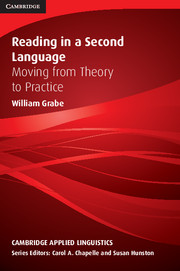II - PATTERNS OF VARIATION IN READING
Published online by Cambridge University Press: 05 August 2012
Summary
Part I identified the component skills that are considered cognitive factors in reading. These include word-recognition skills of various types, syntactic knowledge and processing, discourse processing, strategic processing, and working memory. Part II explores aspects of variation in reading ability that are not specifically associated with individual cognitive differences among learners. Instead, chapters in Part II examine how reading abilities can vary among learners who read in different languages, who read in more than one language, who come from different social contexts, and who read with differing levels of motivation.
Chapter 6 outlines differences in reading abilities that are due to reading in different first languages. The fundamental argument of this chapter is that there are variations in word and sentence processing based on the specific orthographic systems of different languages. These orthographic differences across languages are captured in part by the Orthographic Depth Hypothesis, which is described in some detail. Other orthographic differences across languages that contribute to L1 reading variation are differences in syllable complexities allowed by different languages (phonotactic constraints and consonant clusters), differences in degrees of morphological complexity allowed by differing L1s, and differences in informational density presented by the script. At the same time, the study of reading across different L1s highlights universal aspects of reading, which are discussed in the latter part of the chapter, as well as degrees of L1 transfer at the level of sounds, orthographic segments, morphemes, and words.
Chapter 7 focuses specifically on L1 and L2 relations in L2 reading. The chapter begins with a careful examination of L1–L2 differences, most of which are associated closely with L2 linguistic, socioeducational, and cultural developmental factors.
- Type
- Chapter
- Information
- Reading in a Second LanguageMoving from Theory to Practice, pp. 107 - 108Publisher: Cambridge University PressPrint publication year: 2008



